Effects of Aerosol on Reference Crop Evapotranspiration: A Case Study in Henan Province, China
Abstract
1. Introduction
2. Study Area and Dataset
2.1. Study Area
2.2. Dataset
2.2.1. Meteorological Data
2.2.2. Air Quality Data
2.2.3. Final (FNL) Reanalysis Data
2.2.4. Emissions Listing
3. Methods
3.1. Calculation of Reference Evapotranspiration
3.2. Online Two-Way Coupling of WRF–Chem
3.2.1. Model Setting
3.2.2. Experimental Design
3.3. Simulation Evaluation
4. Results Analysis
4.1. Verification of Simulation Accuracy
4.2. Effects of Aerosol on ET0
4.2.1. Time Scale
4.2.2. Radiation and Aerodynamic Terms
5. Discussion
5.1. Meteorological Elements Simulation Accuracy
5.2. Mechanism of Aerosol Affecting ET0
5.3. Uncertainties of the Study
6. Conclusions
- (1)
- In the online two-way coupling experiment, the simulation results of air temperature and air pressure are better than those of wind speed and relative humidity. WRF–Chem better simulated the fluctuation characteristics and time variation trend of different meteorological elements in Henan Province during May–July 2016, so this method is proven to be reliable for studying the change in ET0 under the action of aerosol. Aerosol reduces air temperature in Henan Province by 0.036KORENKO, wind speed by 0.176 m/s, and air pressure by 20 Pa and increases relative humidity by 1.39%.
- (2)
- The effects of aerosol on ET0 are closely related to aerosol concentration. The change degree of ET0 in a polluted condition is greater than that in an excellent condition. The effects of aerosol on ET0 vary from region to region, and the spatial pattern of ET0 changes in contaminative and excellent conditions is quite different. In any condition, the variation of ET0-d in the whole province is always greater than that of ET0-n. In an excellent condition, aerosol shows a more general positive regulation of ET0-d and ET0-n.
- (3)
- During the study period, ET0-A played a leading role in the change in ET0 in most regions of Henan Province. With the increase in pollution, ET0-R also began to dominate the ET0 changes in more cities. The cause of this phenomenon is related to the season. In this period, enough surface radiation makes the cooling effect of aerosol not obvious.
Author Contributions
Funding
Institutional Review Board Statement
Data Availability Statement
Conflicts of Interest
References
- Peng, S.Z.; Xu, J.Z.; Ding, J.L.; Zhang, R.M. Influence of as and bs Values on Determination of Reference Crop Evapotranspiration by Penman-Monteith Formula. J. Irrig. Drain. 2006, 25, 5–8. [Google Scholar]
- Xu, J.Z.; Peng, S.Z.; Zhang, R.M.; Li, D.X. A neural network model for reference crop evapotranspiration prediction based on weather forecast. J. Hydraul. Eng. 2006, 37, 376–379. [Google Scholar]
- Wang, S.F.; Wang, S.S.; Duan, A.W.; Liu, Z.D.; Luo, C.Q. Evaluation on Several Methods for Estimating ET0 and Modified Hargeaves Formulas. J. Irrig. Drain. 2010, 29, 29–33. [Google Scholar]
- Jia, Y.; Cui, N.B.; Wei, X.P.; Gong, D.Z.; Hu, X.T. Modifying Hargreaves model considering radiation to calculate reference crop evapotranspiration in hilly area of central Sichuan Basin. Trans. Chin. Soc. Agric. Eng. 2016, 32, 152–160. [Google Scholar]
- Xia, X.S.; Zhu, X.F.; Pan, Y.Z.; Zhang, J.S. Influence of Solar Radiation Empirical Values on Reference Crop Evapotranspiration Calculation in Different Regions of China. Trans. Chin. Soc. Agric. Mach. 2020, 51, 254–266. [Google Scholar]
- Vna, B.; Ge, B.; Ja, B. Multi-step ahead modeling of reference evapotranspiration using a multi-model approach. J. Hydrol. 2019, 3, 581. [Google Scholar]
- Thomas, A. Spatial and temporal characteristics of potential evapotranspiration trends over China. Int. J. Climatol. 2015, 20, 381–396. [Google Scholar] [CrossRef]
- Reis, M.M.; Silva, A.J.D.; Junior, J.Z.; Santos, L.D.T.; Lopes, R.M.G. Empirical and learning machine approaches to estimating reference evapotranspiration based on temperature data. Comp. Electr. Agric. 2019, 165, 104937. [Google Scholar] [CrossRef]
- Villaverde, A.B.A.; Pavón-Domínguez, P.; Carmona-Cabezas, R.; Ravé, E.G.D.; Jiménez-Hornero, F.J. Joint multifractal analysis of air temperature, relative humidity and reference evapotranspiration in the middle zone of the Guadalquivir river valley. Agric. For. Meteorol. 2019, 278, 107657. [Google Scholar] [CrossRef]
- Zhang, L.; Traore, S.; Cui, Y.; Luo, Y.; Zhu, G.; Liu, B.; Fipps, G.; Karthikeyan, R.; Singh, V. Assessment of spatiotemporal variability of reference evapotranspiration and controlling climate factors over decades in China using geospatial techniques. Agric. Water Manag. 2019, 213, 499–511. [Google Scholar] [CrossRef]
- IPCC Climate Change 2013—The Physical Science Basis; Cambridge University Press: Cambridge, UK, 2013.
- Wang, Z.; Yang, L. Delinking indicators on regional industry development and carbon emissions: Beijing-Tianjin-Hebei economic band case. Ecol. Ind. 2015, 48, 41–48. [Google Scholar] [CrossRef]
- Takemura, T. Simulation of climate response to aerosol direct and indirect effects with aerosol transport-radiation model. J. Geophys. Res. Atmos. 2005, 110, 3–16. [Google Scholar] [CrossRef]
- Wu, L.; Kaneko, S.; Matsuoka, S. Driving forces behind the stagnancy of China’s energy-related CO2 emissions from 1996 to 1999: The relative importance of structural change, intensity change and scale change. Energy Policy 2005, 33, 319–335. [Google Scholar] [CrossRef]
- Wang, Y.; Che, H.; Ma, J.; Wang, Q.; Shi, G.; Chen, H.; Goloub, P.; Hao, X. Aerosol radiative forcing under clear, hazy, foggy, and dusty weather conditions over Beijing, China. Geophys. Res. Lett. 2009, 36, L06804. [Google Scholar] [CrossRef]
- Qin, S.; Liu, F.; Wang, J.; Sun, B. Analysis and forecasting of the particulate matter (PM) concentration levels over four major cities of China using hybrid models. Atmos. Environ. 2014, 98, 665–675. [Google Scholar] [CrossRef]
- Li, X.; Liu, W.; Chen, Z.; Zeng, G.; Hu, C.; Leon, T.; Liang, J.; Huang, G.; Gao, Z.; Li, Z.; et al. The application of semicircular-buffer-based land use regression models incorporating wind direction in predicting quarterly NO2 and PM10 concentrations. Atmos. Environ. 2015, 103, 18–24. [Google Scholar] [CrossRef]
- Zhang, Y.; Wen, X.Y.; Jang, C.J. Simulating chemistry–aerosol–cloud–radiation–climate feedbacks over the continental U.S. using the online-coupled Weather Research Forecasting Model with chemistry (WRF/Chem). Atmos. Environ. 2010, 44, 3568–3582. [Google Scholar] [CrossRef]
- Zhang, Y. Online-coupled meteorology and chemistry models: History, current status, and outlook. Atmos. Chem. Phys. 2008, 8, 2895–2932. [Google Scholar] [CrossRef]
- Kedia, S.; Cherian, R.; Islam, S.; Das, S.K.; Kaginalkar, A. Regional simulation of aerosol radiative effects and their influence on rainfall over India using WRFChem model. Atmos. Res. 2016, 182, 232–242. [Google Scholar] [CrossRef]
- Vinoj, V.; Rasch, P.J.; Wang, H.; Yoon, J.H.; Ma, P.L.; Landu, K.; Singh, B. Short-term modulation of Indian summer monsoon rainfall by West Asian dust. Nat. Geosci. 2014, 7, 308–313. [Google Scholar] [CrossRef]
- Mao, J.J. A Study on Characteristics of Aerosol Inversion and Spatial and Temporal Distribution over East China with MODIS Data. Master’s Thesis, Nanjing University of Information Science and Technology, Nanjing, China, 2011. [Google Scholar]
- Wang, Z.; Wang, Z.F.; Li, J.; Zheng, H.T.; Yan, P.Z.; Li, J.J. Development of a Meteorology−Chemistry Two-Way Coupled Numerical Model (WRF−NAQPMS) and Its Application in a Severe Autumn Haze Simulation over the Beijing−Tianjin−Hebei Area, China. Clim. Environ. Res. 2014, 19, 153–163. [Google Scholar]
- Yang, D.D.; Wang, T.J.; Li, S.; Ma, C.Q.; Liu, C.; Yang, F. Air pollution characteristics and source tracking in the Yangtze River Delta based on cruise observation. China Environ. Sci. 2019, 39, 3595–3603. [Google Scholar]
- Yu, Z.Q.; Ma, J.H.; Cao, Y.; Chang, L.Y.; Xu, J.M.; Zhou, G.Q. Numerical simulations of sources and transport pathways of different PM2.5 pollution types in Shanghai. China Environ. Sci. 2019, 39, 21–31. [Google Scholar]
- Yu, C.X.; Shi, C.E.; Ling, X.F.; Zhu, J.Y.; Fan, Y. Analysis of a severe fog-haze process in central and eastern China based oncomprehensive observations. Acta Sci. Circumst. 2020, 40, 2346–2355. [Google Scholar]
- Li, Y.F.; Chen, W.Z. Correlation between aerosol optical depth and ocean primary productivity based on MODIS and CALIOP data. China Environ. Sci. 2017, 37, 76–86. [Google Scholar]
- Yu, Y.; Wang, Z.H.; Cui, X.D.; Chen, F.; Xu, H.H. Effects of Emission Reductions of Key Sources on the PM2.5 Concentrations in the Yangtze River Delta. Environ. Sci. 2019, 40, 11–23. [Google Scholar]
- Roderick, M.L.; Farquhar, G.D. The Cause of Decreased Pan Evaporation over the Past 50 Years. Science 2002, 298, 1410–1411. [Google Scholar] [CrossRef]
- Liu, X.W.; Zhang, X.Y.; Zhang, X.Y. A review of the research on crop responses to the increase in aerial aerosol. Acta Ecol. Sin. 2016, 36, 2084–2090. [Google Scholar]
- Zhang, X.Y.; Wang, S.F.; Sun, H.Y.; Chen, S.Y.; Shao, L.W.; Liu, X.W. Contribution of cultivar, fertilizer and weather to yield variation of winter wheat over three decades: A case study in the North China Plain. Eur. J. Agron. 2013, 50, 52–59. [Google Scholar] [CrossRef]
- FNL Reanalysis Data. Available online: https://rda.ucar.edu/datasets/ds083.3/ (accessed on 16 June 2021).
- Zhang, Q.; Streets, D.G.; Carmichael, G.R.; He, K.B.; Huo, H.; Kannari, A.; Klimont, Z.; Park, I.S.; Reddy, S.; Fu, J.S. Asian emissions in 2006 for the NASA INTEX-B mission. Atmos. Chem. Phys. 2009, 9, 5131–5153. [Google Scholar] [CrossRef]
- Li, M.; Zhang, Q.; Streets, D.G.; He, K.B.; Zhang, Y. Mapping Asian anthropogenic emissions of non-methane volatile organic compounds to multiple chemical mechanisms. Atmos. Chem. Phys. 2013, 13, 32649–32701. [Google Scholar] [CrossRef]
- Zheng, B.; Huo, H.; Zhang, Q.; Yao, Z.L.; Wang, X.T.; Yang, X.F.; Liu, H.; He, K.B. High-resolution mapping of vehicle emissions in China in 2008. Atmos. Chem. Phys. 2014, 14, 9787–9805. [Google Scholar] [CrossRef]
- Liu, F.; Zhang, Q.; Tong, D.; Zheng, B.; Li, M.; Huo, H.; He, K.B. High-resolution inventory of technologies, activities, and emissions of coal-fired power plants in China from 1990 to 2010. Atmos. Chem. Phys. 2015, 15, 18787–18837. [Google Scholar] [CrossRef]
- Allen, R.G.; Pereira, L.S.; Raes, D.; Smith, M.; Allen, R.G.; Pereira, L.S.; Martin, S. Crop Evapotranspiration Guidelines for Computing Crop Water Requirements; Food and Agriculture Organization of United Nation: Rome, Italy, 1998; p. 56. [Google Scholar]
- Roderick, M.L.; Farquhar, G.D. Geoengineering: Hazy, cool and well fed? Nat. Clim. Chang. 2012, 2, 76–77. [Google Scholar] [CrossRef]
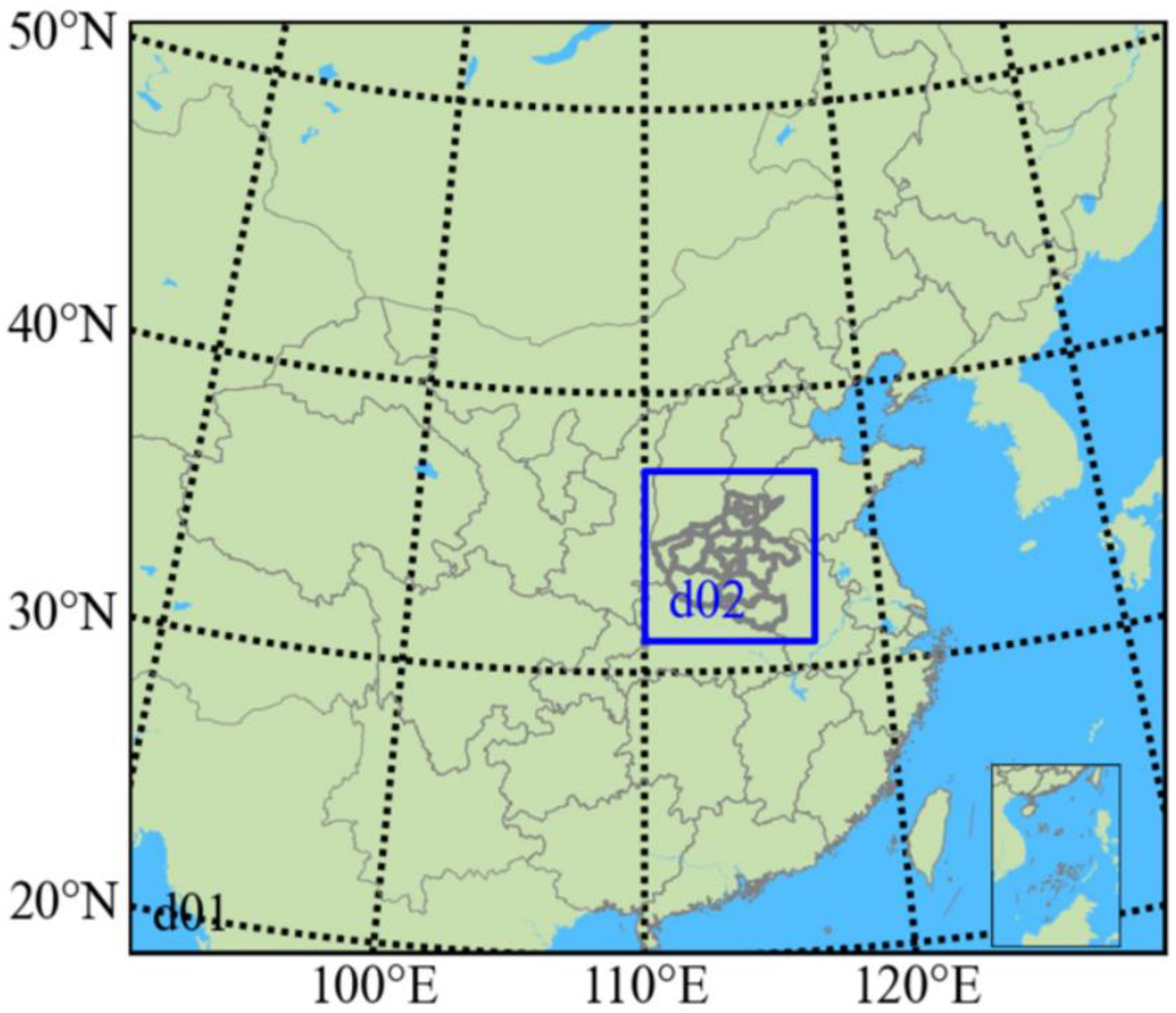
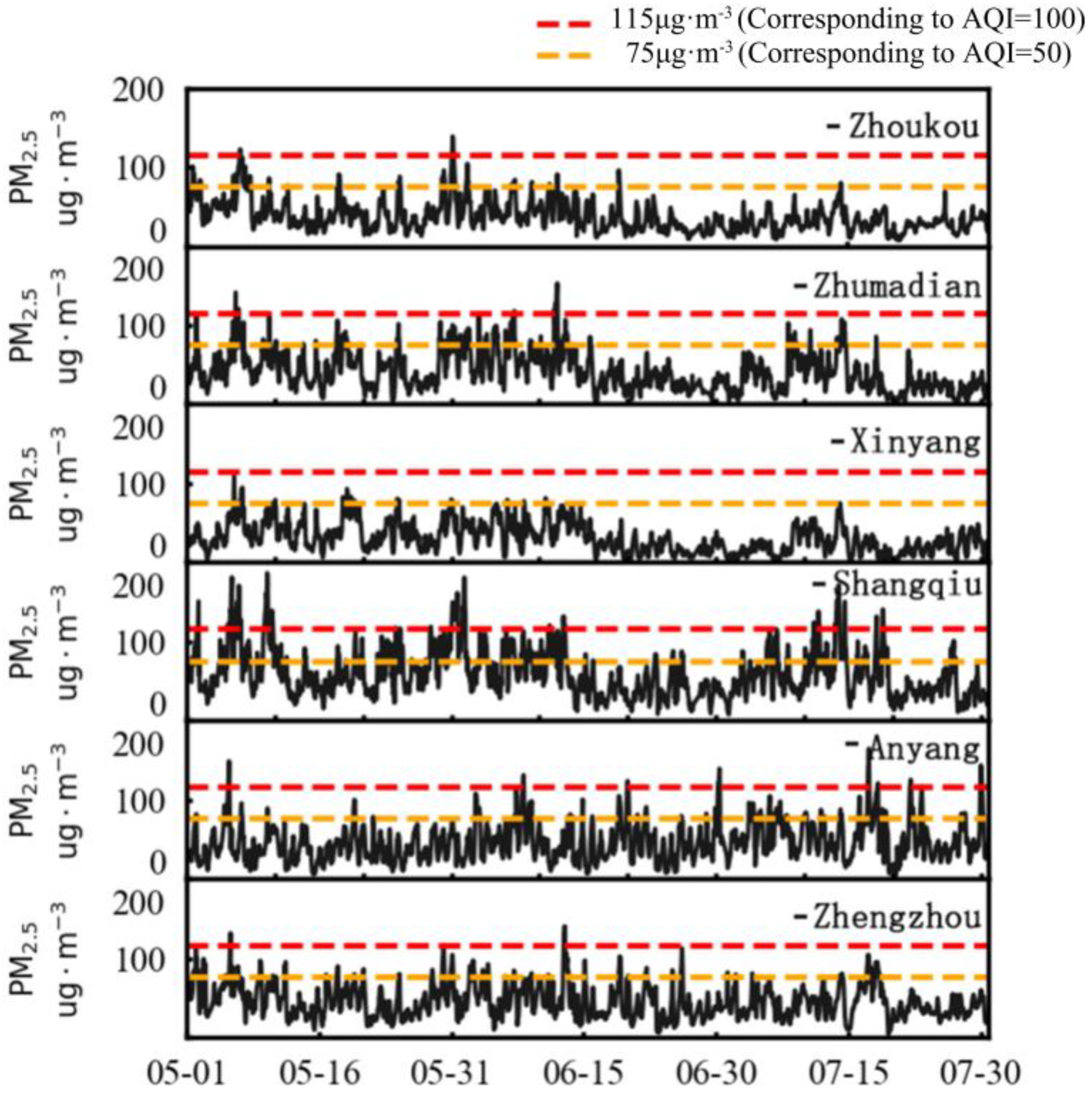

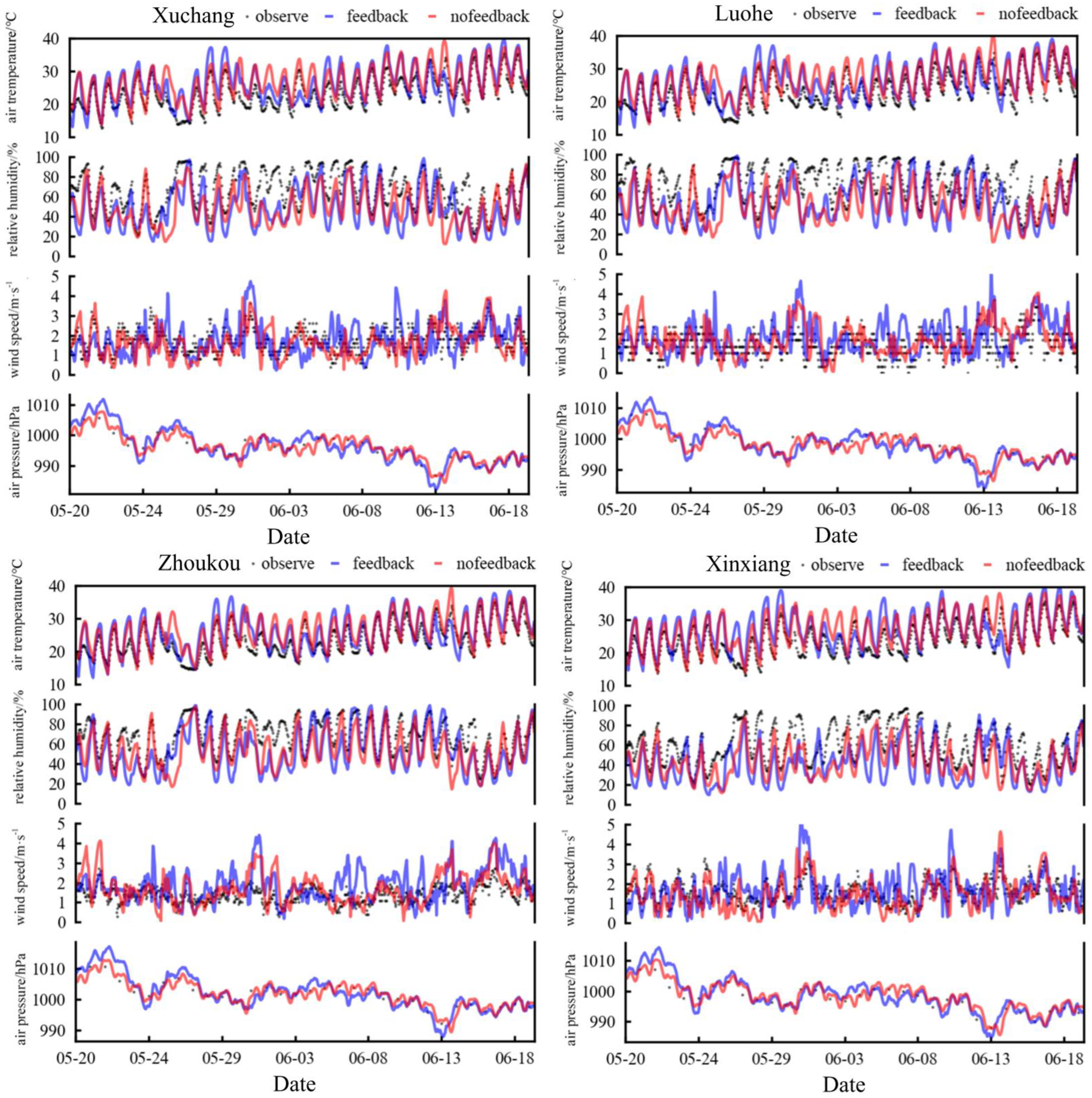
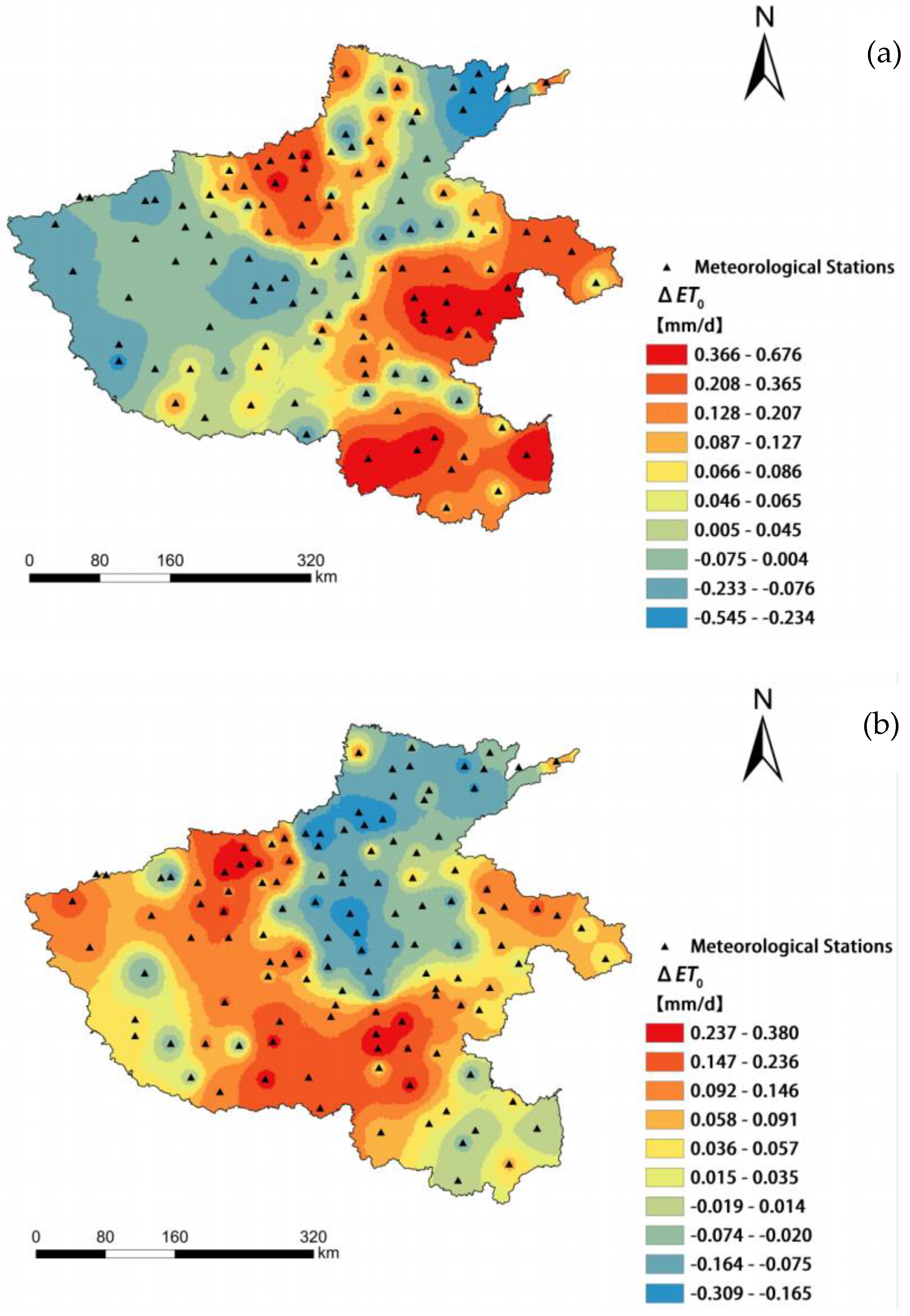
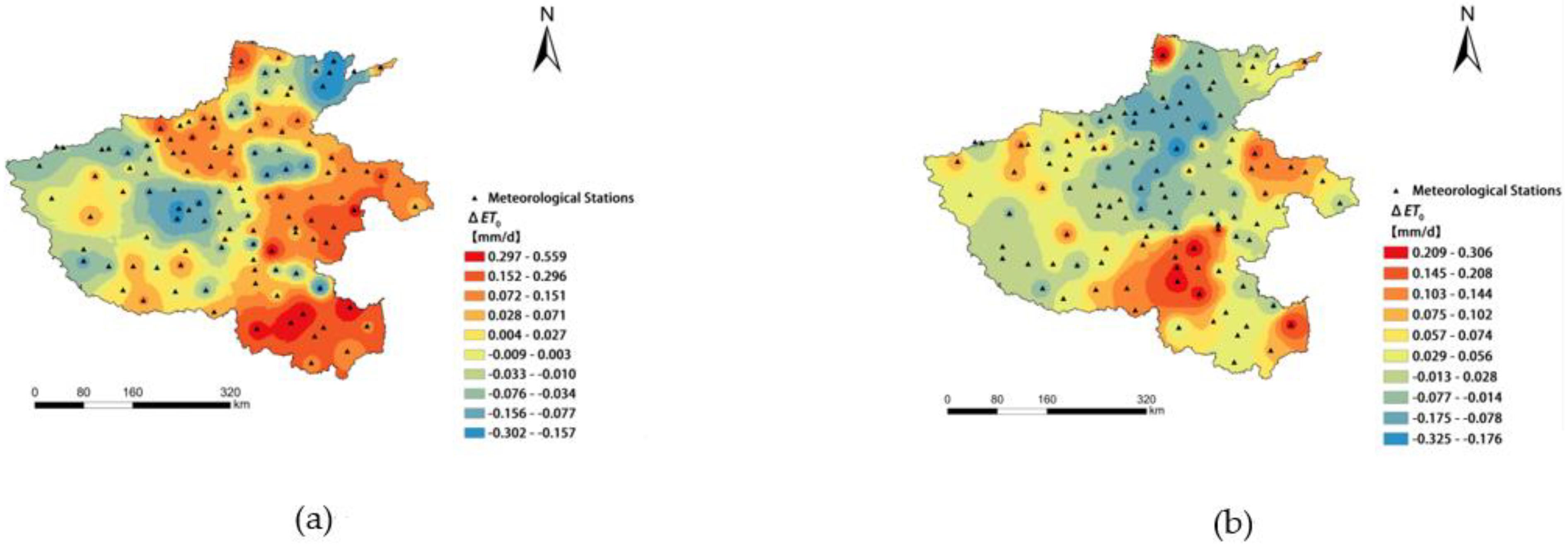

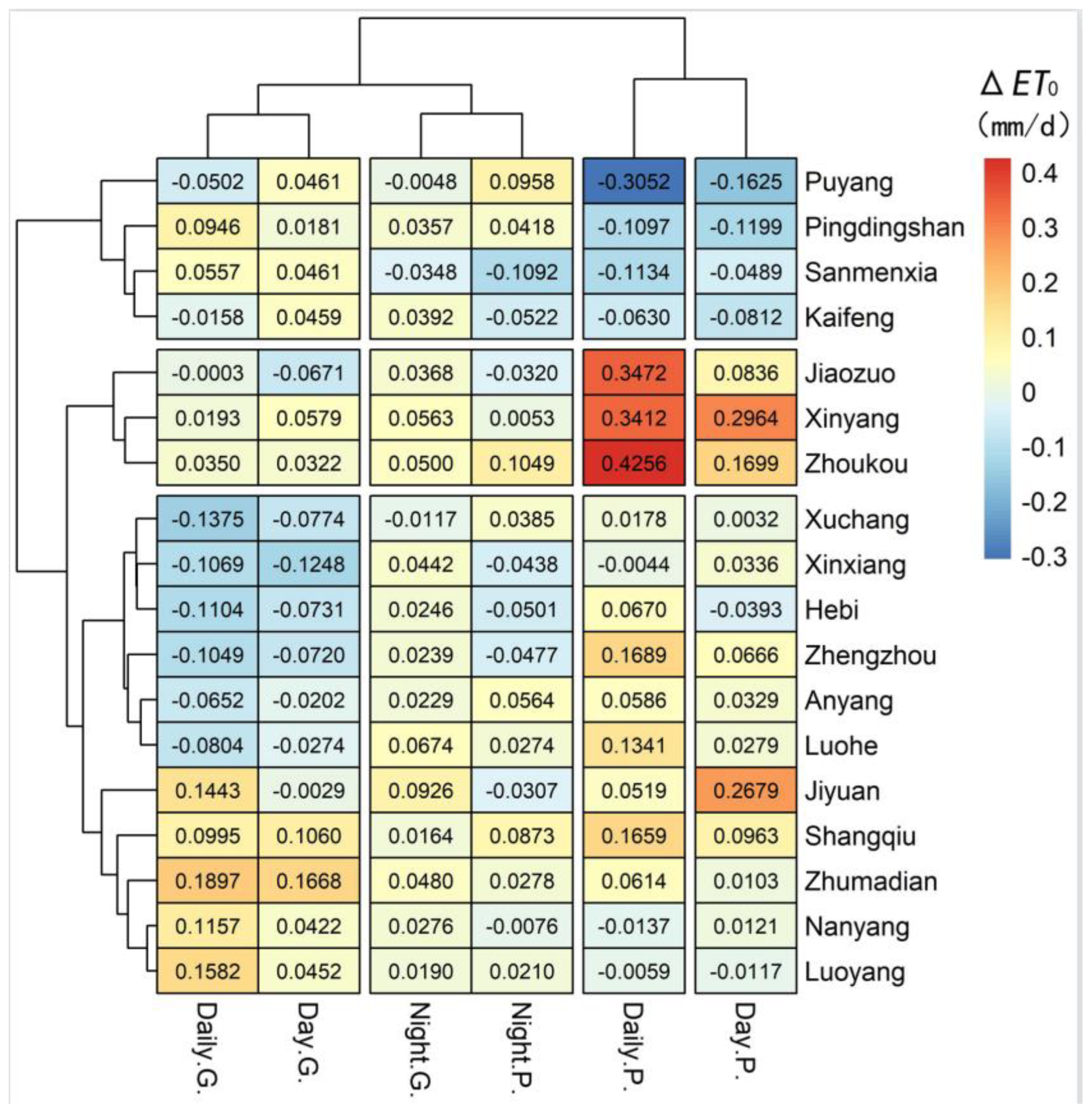
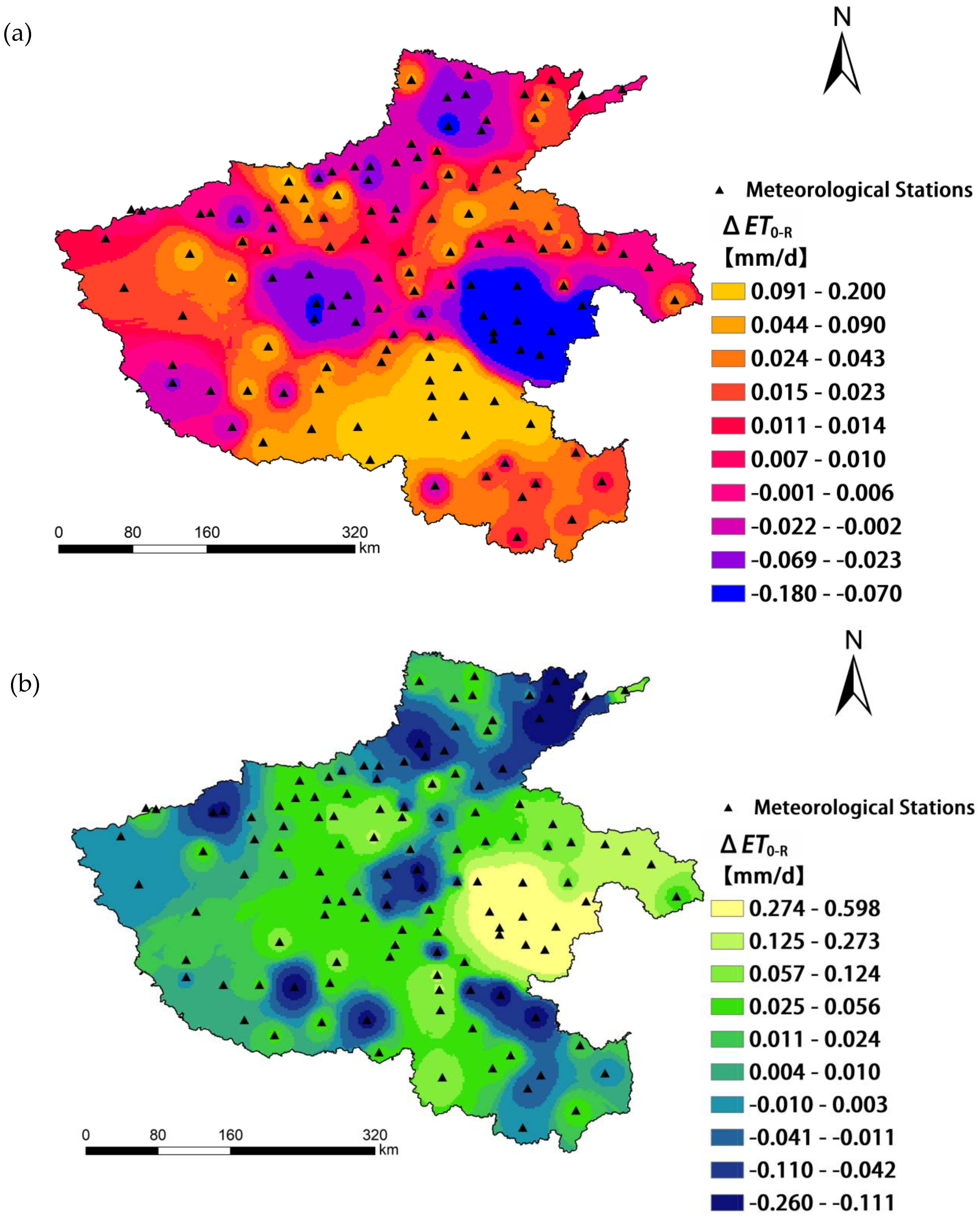
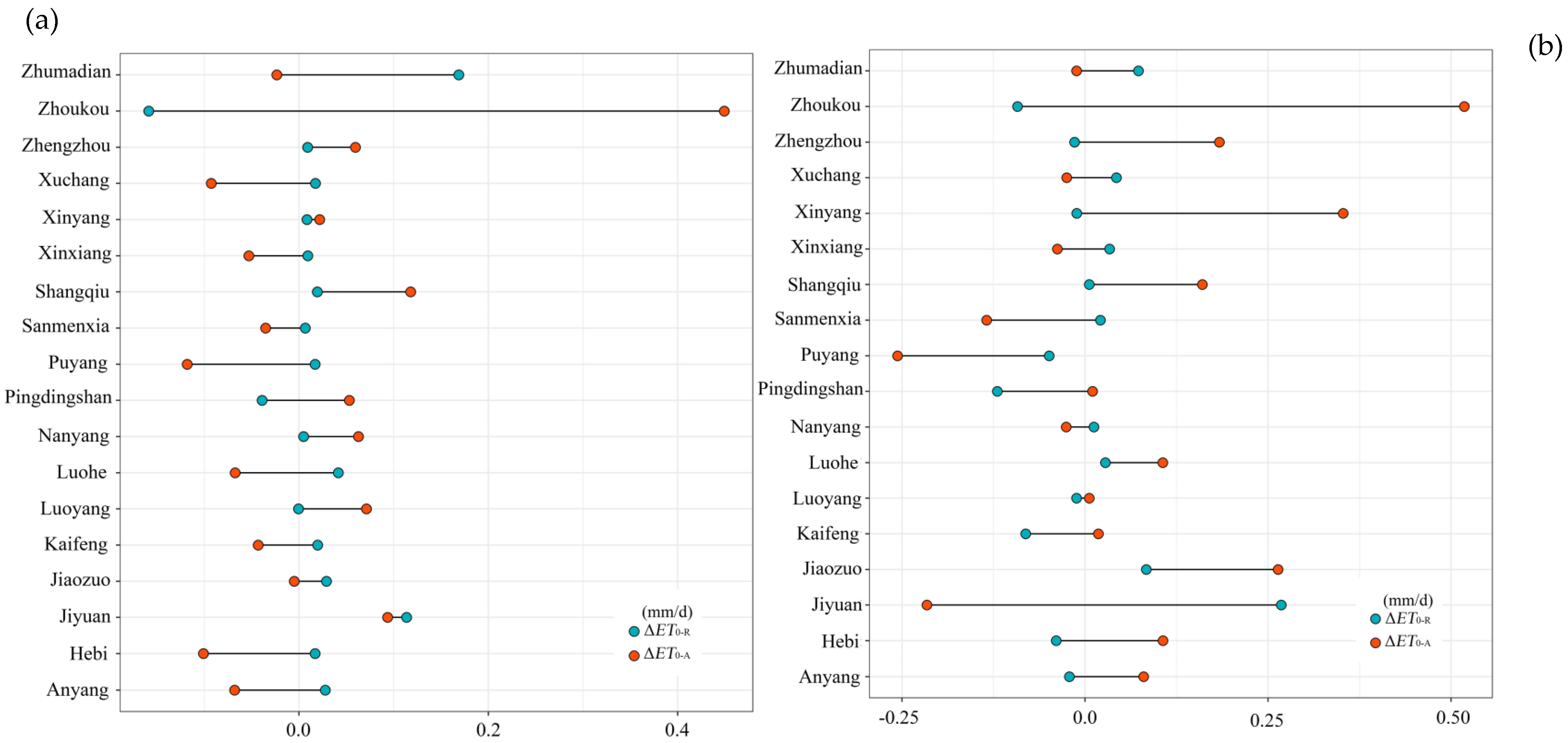
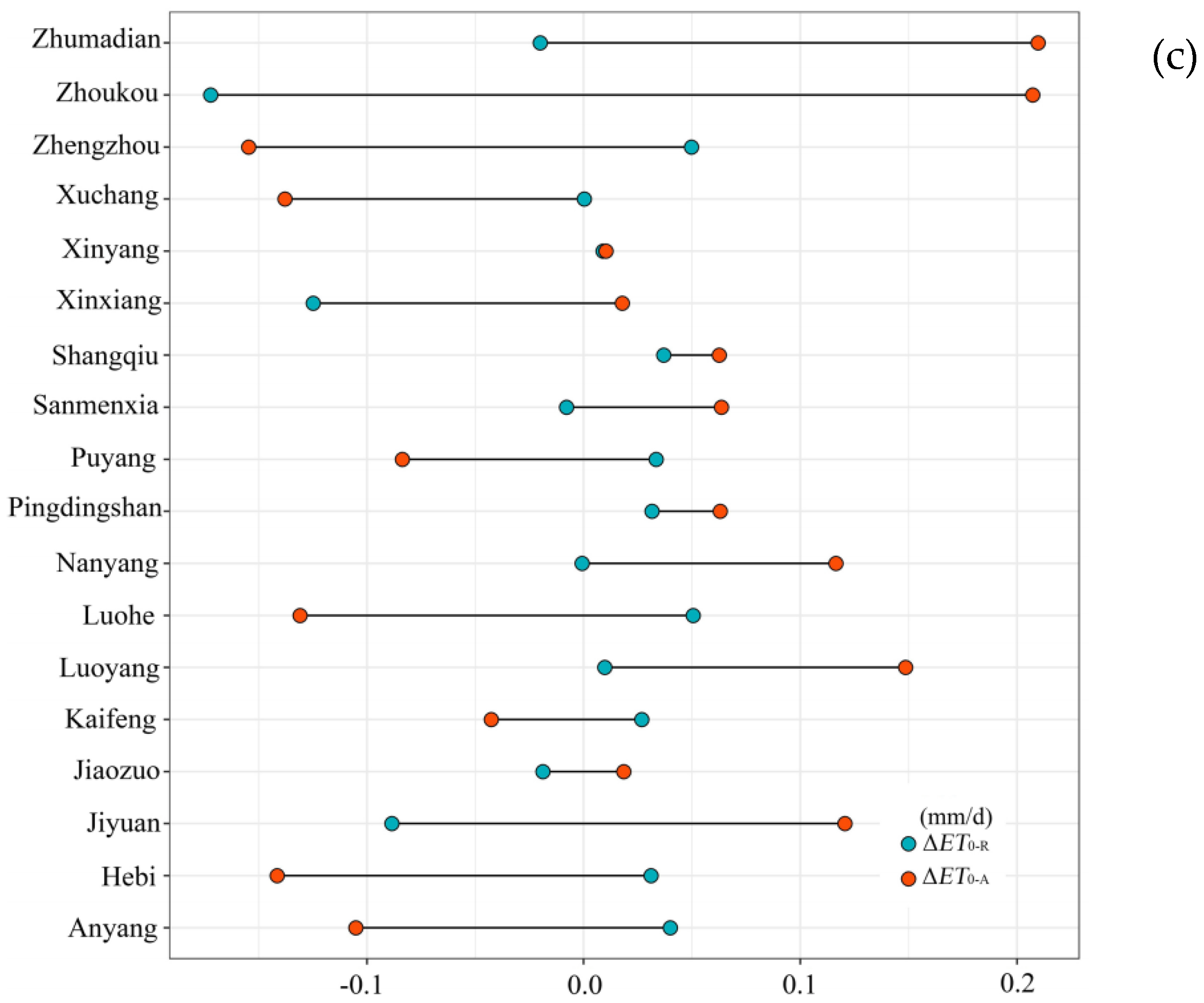
| Date | Group | Simulation of Meteorological Elements | |
|---|---|---|---|
| Initialization | 10 May 2016–19 May 2016 | fb: contains all meteorological and chemical processes as well as aerosol radiation and feedback fdda: assimilates meteorological observations nofb: shuts down the emission source for simulation | air temperature at 2 m (T), relative humidity (RH), air pressure (P), and wind speed at 10 m(u), short-wave radiation (SW), and long-wave radiation (LW) |
| Analysis | 20 May 2016–20 June 2016 |
| City | T | u | RH | P | ||||
|---|---|---|---|---|---|---|---|---|
| R2 | NMB | R2 | NMB | R2 | NMB | R2 | NMB | |
| Anyang | 0.906 | 12.11% | 0.700 | −32.61% | 0.888 | −18.03% | 0.998 | 0.47% |
| Hebi | 0.906 | 12.14% | 0.643 | −24.87% | 0.825 | −22.09% | 0.998 | −0.78% |
| Jiaozuo | 0.902 | 15.21% | 0.670 | −11.63% | 0.830 | −35.86% | 0.997 | 0.01% |
| Kaifeng | 0.890 | 13.61% | 0.574 | −0.04% | 0.813 | −17.40% | 0.997 | −0.01% |
| Luoyang | 0.889 | 13.12% | 0.540 | −10.04% | 0.805 | −18.22% | 0.996 | 0.06% |
| Nanyang | 0.911 | 12.99% | 0.662 | −15.20% | 0.861 | −15.14% | 0.998 | −0.15% |
| Pingdingshan | 0.884 | 14.35% | 0.580 | −8.87% | 0.794 | −16.53% | 0.997 | −0.22% |
| Puyang | 0.908 | 11.63% | 0.640 | −5.54% | 0.831 | −28.75% | 0.998 | −0.01% |
| Sanmenxia | 0.907 | 15.16% | 0.512 | −27.07% | 0.797 | −13.03% | 0.995 | −0.40% |
| Shangqiu | 0.904 | 11.07% | 0.590 | 13.82% | 0.823 | −21.28% | 0.998 | −0.02% |
| Luohe | 0.896 | 15.33% | 0.654 | 17.15% | 0.755 | −18.37% | 0.997 | 0.01% |
| Xinxiang | 0.903 | 13.66% | 0.672 | −8.18% | 0.862 | −20.40% | 0.997 | −0.01% |
| Xinyang | 0.889 | 12.36% | 0.705 | 6.21% | 0.845 | −18.07% | 0.997 | 0.53% |
| Xuchang | 0.893 | 16.12% | 0.572 | −5.87% | 0.780 | −19.23% | 0.997 | 0.04% |
| Zhengzhou | 0.887 | 13.69% | 0.591 | −2.83% | 0.829 | −18.23% | 0.997 | 1.44% |
| Zhoukou | 0.890 | 11.89% | 0.572 | 24.13% | 0.819 | −11.87% | 0.998 | −0.02% |
| Jiyuan | 0.905 | 10.12% | 0.541 | 17.69% | 0.815 | 16.28% | 0.997 | −0.18% |
| Zhumadian | 0.916 | 13.96% | 0.619 | 8.84% | 0.831 | −13.26% | 0.998 | −0.06% |
Disclaimer/Publisher’s Note: The statements, opinions and data contained in all publications are solely those of the individual author(s) and contributor(s) and not of MDPI and/or the editor(s). MDPI and/or the editor(s) disclaim responsibility for any injury to people or property resulting from any ideas, methods, instructions or products referred to in the content. |
© 2022 by the authors. Licensee MDPI, Basel, Switzerland. This article is an open access article distributed under the terms and conditions of the Creative Commons Attribution (CC BY) license (https://creativecommons.org/licenses/by/4.0/).
Share and Cite
Wang, S.; Xu, X.; Lei, L.; Gao, Y. Effects of Aerosol on Reference Crop Evapotranspiration: A Case Study in Henan Province, China. Agronomy 2023, 13, 82. https://doi.org/10.3390/agronomy13010082
Wang S, Xu X, Lei L, Gao Y. Effects of Aerosol on Reference Crop Evapotranspiration: A Case Study in Henan Province, China. Agronomy. 2023; 13(1):82. https://doi.org/10.3390/agronomy13010082
Chicago/Turabian StyleWang, Shengfeng, Xinmiao Xu, Longwei Lei, and Yang Gao. 2023. "Effects of Aerosol on Reference Crop Evapotranspiration: A Case Study in Henan Province, China" Agronomy 13, no. 1: 82. https://doi.org/10.3390/agronomy13010082
APA StyleWang, S., Xu, X., Lei, L., & Gao, Y. (2023). Effects of Aerosol on Reference Crop Evapotranspiration: A Case Study in Henan Province, China. Agronomy, 13(1), 82. https://doi.org/10.3390/agronomy13010082







